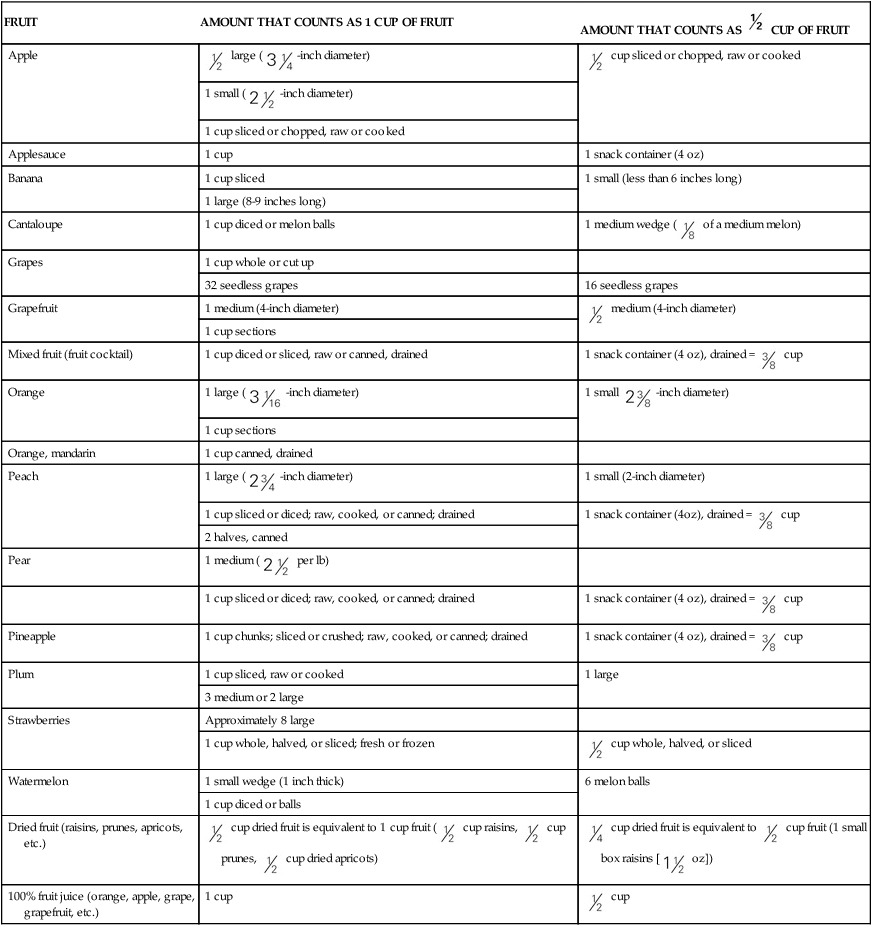The Dietary Reference Intake (DRI) considers the concern of providing nutrient requirements necessary to prevent deficiencies and toxicity from overdoses and accounting for the value of nutrient intake as a means of reducing disease risk.1 Recommendations within the DRI documents include the use of fortified foods or supplements for particular nutrients, such as folic acid for women of childbearing age to ensure proper neural tube formation of the fetus during pregnancy. A primary deficiency of a vitamin occurs when the vitamin is not consumed in sufficient amounts to meet physiologic needs. A secondary deficiency develops when absorption is impaired or excess excretion occurs, limiting bioavailability. Most deficiencies are detected through clinical and biochemical assessment; specific diagnostic and laboratory procedures are beyond the scope of this text and are available elsewhere.2 Health professionals can also take into account other special circumstances that may initiate vitamin deficiencies. Individuals dealing with long-term chronic disorders that affect the total body response, such as acquired immunodeficiency syndrome (AIDS) or liver or kidney disorders, have special vitamin concerns because the metabolic processes of the body may be compromised by these disorders and by the medications prescribed. Deficiencies have been documented that were possibly caused by the effects of cancer treatment, use of multiple alternative therapies, and lifestyle behaviors. These deficiencies were at first misdiagnosed because vitamin deficiencies were no longer thought to occur.3–5 Toxicities of vitamins rarely occur naturally from food consumption. Instead, inappropriate use of supplements may be toxic to our bodies. Vitamins have been studied for their physiologic effect or basic need for health maintenance (Box 7-1). The recommended levels reflect this knowledge. Use of vitamin supplements at megadose levels is equivalent to a pharmacologic effect, with potential druglike physical responses. Some vitamins have UL; for others, a megadose (i.e., 10 times the RDA for a specific nutrient) of a vitamin is considered the highest amount of the nutrient that will not cause adverse health effects. Because most vitamins have not been studied to determine function and safety at these megadose levels, extensive use without guidance can be problematic. If we consume more than the daily requirement of a fat-soluble vitamin, our bodies store the excess rather than excrete it (Box 7-2). The DRI for fat-soluble vitamins takes into account this storage capacity. Although storage is expected in organs such as the liver and spleen, other fatty tissues in the body can also retain excessive amounts of fat-soluble vitamins. Overloading the storage capabilities can be toxic and produce illness; toxicity rarely comes from excessive dietary intake but rather from improper use of vitamin supplements. It is always best to consume vitamins from food sources. Although synthetic forms of vitamins will perform vitamin functions, there may be other factors in foods that provide benefits. For instance, broccoli and other cruciferous vegetables contain a wide variety of chemicals, including sulforaphane, which is a phytochemical (Box 7-3). Phytochemicals are nonnutritive substances in plant-based foods that appear to have disease-fighting properties Sulforaphane appears to block the growth of tumors in animals. Broccoli, along with onions and grapes, also contains flavonols, which seems to reduce the risk of coronary artery disease (CAD) and cancer while having an anti-inflammatory effect.6 Lean pork, whole or enriched grains and flours, legumes, seeds, and nuts are good sources of thiamine. As a water-soluble vitamin, some thiamine can be lost in food processing or when foods are cooked at home.2 Thiamine may be leaked into cooking fluid or destroyed by heat. Generally, however, most of us consume sufficient amounts of thiamine. Thiamine deficiency alters the nervous, muscular, gastrointestinal (GI), and cardiovascular systems.7 In beriberi, a severe, chronic deficiency results, characterized by ataxia (muscle weakness and loss of coordination), pain, anorexia, mental disorientation, and tachycardia (rapid beating of the heart). Wet beriberi manifests with edema, affecting cardiac function by weakening the heart muscle and vascular system. Dry beriberi affects the nervous system, producing paralysis and extreme muscle wasting. Marginal deficiencies may occur, producing psychologic disturbances, recurrent headaches, extreme tiredness, and irritability.7 A severe deficiency of thiamine may cause a cerebral form of beriberi called Wernicke-Korsakoff syndrome. It is the most common disorder of the central nervous system as a neuropsychiatric affect of chronic excessive alcohol intake on nutritional status.8 Others at risk for this syndrome include individuals with severe GI disease, human immunodeficiency virus (HIV), and improper parenteral glucose solutions.7 The effects of this thiamine deficiency syndrome may cause the loss of memory, extreme mental confusion, and ataxia exhibited by people with chronic excessive alcohol ingestion. Clinically, care must be taken when a malnourished person is given parenteral fluids containing dextrose. Parenteral fluids should contain a mix of B vitamins; otherwise, the marginal thiamine levels of nutritionally depleted individuals, combined with a sudden increase of glucose to the brain, can initiate Wernicke-Korsakoff syndrome, regardless of the level of alcohol intake. Others at risk for thiamine deficiency include renal patients who are undergoing dialysis, are receiving parenteral nutrition, have HIV-AIDS, have persistent vomiting (hyperemesis gravidarum), have anorexia nervosa, have gastrectomy, and have genetic disorders that affect thiamine use.7 As gastric bypass surgeries increase, instances of peripheral neuropathy from thiamine deficiency may increase as well. Nutritional deficiencies tend to be multiple rather than single, and it is difficult to separate symptoms. If an individual is deficient in a nutrient such as riboflavin, more than likely a deficiency of other nutrients also will be present. For example, esophageal cancer is associated with deficiencies of riboflavin and zinc, particularly in Africa, Iran, and China. In the United States, riboflavin deficiency may be related to anorexia nervosa, inadequate intake when active individuals restrict caloric intake, and lactose intolerance9—all of which are associated with potential multiple nutritional deficiencies. Pellagra, the niacin deficiency disorder, is characterized by the three D’s, as follows:10 1. Diarrhea: Damage to the GI tract affects digestion, absorption, and excretion of food, leading to glossitis, vomiting, and diarrhea. 2. Dermatitis: A symmetric scaly rash occurs only on skin exposed to the sun (Figure 7-1). 3. Dementia: As the central nervous system becomes affected in severe deficiencies, confusion, anxiety, insomnia, and paranoia develop. In the United States, health professionals need to be vigilant to recognize the symptoms of vitamin deficiencies among patients undergoing specialized treatments or experiencing disorders that may negatively affect their nutritional status. For example, pellagra may develop among people with chronic excessive alcohol ingestion, particularly if combined with homelessness and failure to eat regularly (not using shelter-based meal programs).11 Several cases have been reported in which the symptom of dermatitis was not recognized as pellagra. In one situation, the simultaneous use of several alternative remedies initiated pellagra, although the individual consumed sufficient dietary niacin.4 Another report discusses pellagra dermatitis possibly caused by cancer treatment (5-fluorouracil) exacerbating the low niacin levels of the patient.1 Pellagra may even occur, as a secondary condition to anorexia nervosa.12 In contrast, in Africa and Asia, pellagra still occurs among the general population. The UL for niacin is 35 mg NE per day. When preformed niacin and nicotinic acid (but not niacinamide) are consumed in levels greater than the UL, the vascular system is affected, producing a flushing effect throughout the body. A pharmacologic dose is 3 to 9 g of niacin, compared with the RDA of 16 mg NE. Niacin has been used therapeutically because megadoses may lower total cholesterol and low-density lipoprotein (LDL) and increase high-density lipoprotein (HDL).10 These therapeutic doses, however, must be medically administered to guard against liver damage and related gout and arthritic reactions. Supplements of B6, folate, and B12 may reduce risk of CAD by lowering homocysteine levels (see also “Overcoming Barriers” later in this chapter). Several epidemiologic studies suggest that the greater the dietary intake of B6, the lower the risk of colorectal cancer in women.13,14
Vitamins
![]() http://evolve.elsevier.com/Grodner/foundations/
http://evolve.elsevier.com/Grodner/foundations/ ![]() Nutrition Concepts Online
Nutrition Concepts Online
Role in Wellness
Vitamin Categories
Food Sources
Water–Soluble Vitamins
Thiamine (B1)
Recommended Intake and Sources
Deficiency
Riboflavin (B2)
Deficiency
Niacin (B3)
Deficiency
Toxicity
Pyridoxine (B6)
Function
![]()
Stay updated, free articles. Join our Telegram channel

Full access? Get Clinical Tree


Vitamins
Get Clinical Tree app for offline access




 cup of dried fruit can be considered as 1 cup from the fruit group. The specific amounts outlined in the following table count as 1 cup of fruit (in some cases equivalents for
cup of dried fruit can be considered as 1 cup from the fruit group. The specific amounts outlined in the following table count as 1 cup of fruit (in some cases equivalents for  cup are also shown) toward your daily recommended intake.
cup are also shown) toward your daily recommended intake. CUP OF FRUIT
CUP OF FRUIT large (
large ( -inch diameter)
-inch diameter) cup sliced or chopped, raw or cooked
cup sliced or chopped, raw or cooked -inch diameter)
-inch diameter) of a medium melon)
of a medium melon) medium (4-inch diameter)
medium (4-inch diameter) cup
cup -inch diameter)
-inch diameter) -inch diameter)
-inch diameter) -inch diameter)
-inch diameter) cup
cup per lb)
per lb) cup
cup cup
cup cup whole, halved, or sliced
cup whole, halved, or sliced cup dried fruit is equivalent to 1 cup fruit (
cup dried fruit is equivalent to 1 cup fruit ( cup raisins,
cup raisins,  cup prunes,
cup prunes,  cup dried apricots)
cup dried apricots) cup dried fruit is equivalent to
cup dried fruit is equivalent to  cup fruit (1 small box raisins [
cup fruit (1 small box raisins [ oz])
oz]) cup
cup

